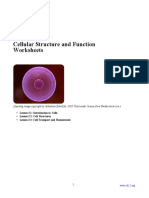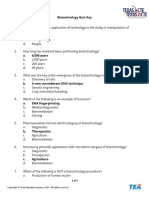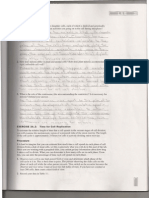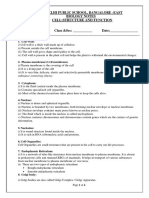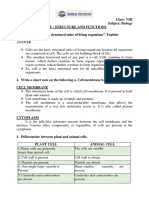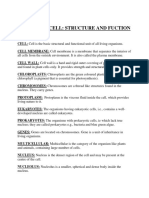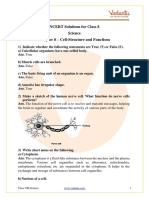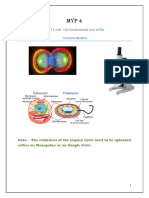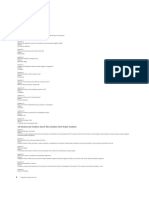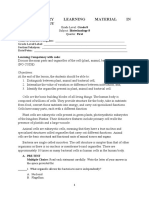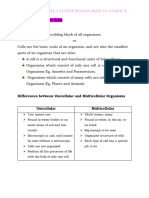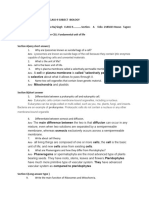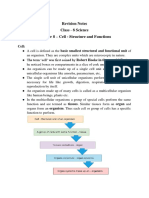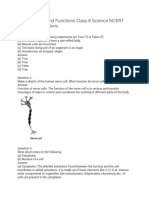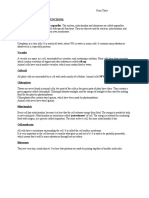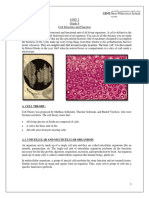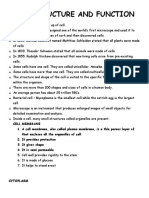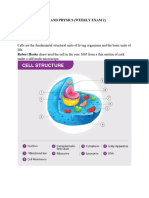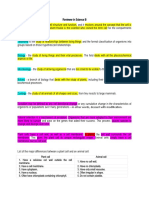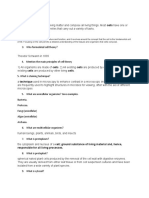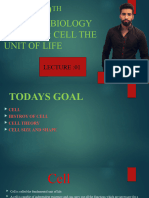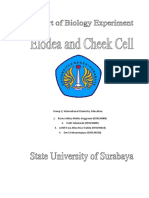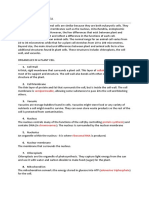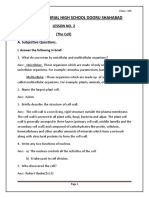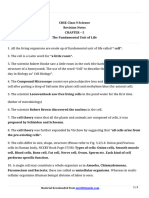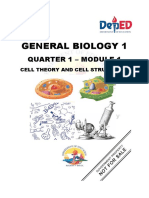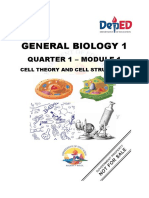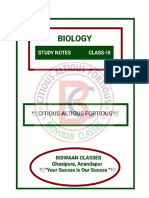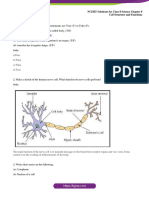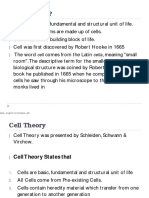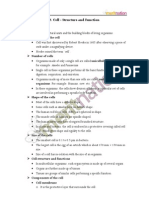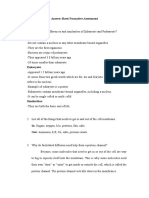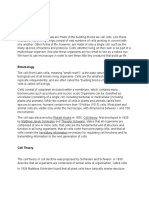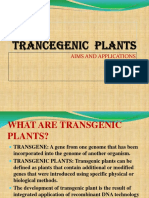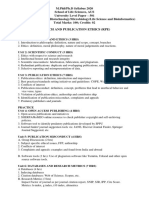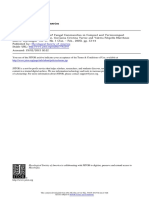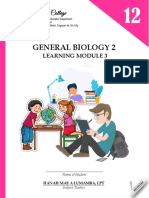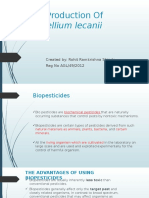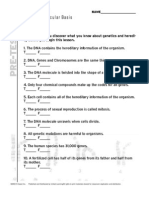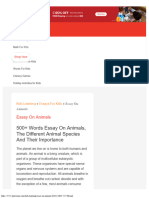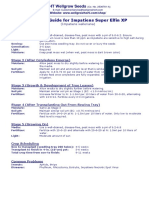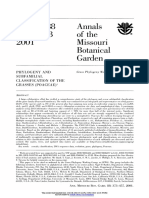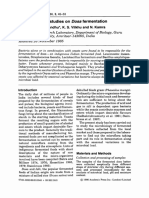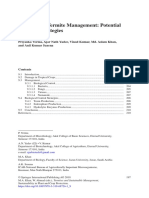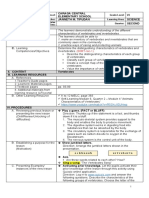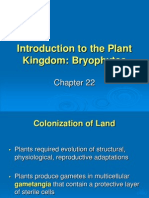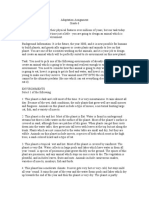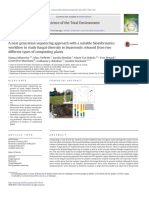0 ratings0% found this document useful (0 votes)
10 views1-Life Processes
1-Life Processes
Uploaded by
Tahmeed AhmedThis document discusses the key components and structures of cells. It defines the five kingdoms of life as plant, animal, fungi, protoctist, and bacteria. It describes the cytoplasm as the living material within cells, and the nucleus as the largest organelle that controls cell activities and contains genetic material. The cell surface membrane forms a boundary around cells and is partially permeable. The mitochondrion is an organelle that carries out cellular respiration. Plant cells contain a cell wall not found in animal cells, which is made of cellulose and helps the cell maintain its shape. Similarities between plant and animal cells include the presence of a cell membrane and nucleus. Differences are that plant cells contain a cell wall and chloroplasts
Copyright:
© All Rights Reserved
Available Formats
Download as DOCX, PDF, TXT or read online from Scribd
1-Life Processes
1-Life Processes
Uploaded by
Tahmeed Ahmed0 ratings0% found this document useful (0 votes)
10 views3 pagesThis document discusses the key components and structures of cells. It defines the five kingdoms of life as plant, animal, fungi, protoctist, and bacteria. It describes the cytoplasm as the living material within cells, and the nucleus as the largest organelle that controls cell activities and contains genetic material. The cell surface membrane forms a boundary around cells and is partially permeable. The mitochondrion is an organelle that carries out cellular respiration. Plant cells contain a cell wall not found in animal cells, which is made of cellulose and helps the cell maintain its shape. Similarities between plant and animal cells include the presence of a cell membrane and nucleus. Differences are that plant cells contain a cell wall and chloroplasts
Original Description:
Original Title
1-Life_Processes
Copyright
© © All Rights Reserved
Available Formats
DOCX, PDF, TXT or read online from Scribd
Share this document
Did you find this document useful?
Is this content inappropriate?
This document discusses the key components and structures of cells. It defines the five kingdoms of life as plant, animal, fungi, protoctist, and bacteria. It describes the cytoplasm as the living material within cells, and the nucleus as the largest organelle that controls cell activities and contains genetic material. The cell surface membrane forms a boundary around cells and is partially permeable. The mitochondrion is an organelle that carries out cellular respiration. Plant cells contain a cell wall not found in animal cells, which is made of cellulose and helps the cell maintain its shape. Similarities between plant and animal cells include the presence of a cell membrane and nucleus. Differences are that plant cells contain a cell wall and chloroplasts
Copyright:
© All Rights Reserved
Available Formats
Download as DOCX, PDF, TXT or read online from Scribd
Download as docx, pdf, or txt
0 ratings0% found this document useful (0 votes)
10 views3 pages1-Life Processes
1-Life Processes
Uploaded by
Tahmeed AhmedThis document discusses the key components and structures of cells. It defines the five kingdoms of life as plant, animal, fungi, protoctist, and bacteria. It describes the cytoplasm as the living material within cells, and the nucleus as the largest organelle that controls cell activities and contains genetic material. The cell surface membrane forms a boundary around cells and is partially permeable. The mitochondrion is an organelle that carries out cellular respiration. Plant cells contain a cell wall not found in animal cells, which is made of cellulose and helps the cell maintain its shape. Similarities between plant and animal cells include the presence of a cell membrane and nucleus. Differences are that plant cells contain a cell wall and chloroplasts
Copyright:
© All Rights Reserved
Available Formats
Download as DOCX, PDF, TXT or read online from Scribd
Download as docx, pdf, or txt
You are on page 1of 3
Pearson Edexcel International GCSE (9-1) Biology
Life Processes
Chapter No. 1, Page No. 3
1. Name the five organisms kingdoms.
Ans. 1. Plant (Plantae)
2. Animal (Animalia)
3. Fungi
4. Protoctist
5. Bacteria
2. What is a cytoplasm?
Ans. The living material that makes up a cell is called cytoplasm. Its material is
somewhere between a solid and a liquid. It’s made up of a complex material made
of many different structures. Most cells have a defined nucleus.
3. What is a nucleus?
Ans. The largest organelle in the cell is the nucleus. Nearly all cells have a
nucleus. It controls the activities of the cell, and contains chromosomes which
carry the genetic material, or genes.
4. What is a cell surface membrane?
Ans. All cells are surrounded by a cell surface membrane. It is a thin layer like a
‘skin’ on the surface of the cell. It forms a boundary between the cytoplasm of the
cell and the outside. However, it isn’t a complete barrier. Some chemicals can
pass into the cell and others can pass out. The membrane is known as partially
permeable.
5. What is the mitochondrion?
Ans. The mitochondrion is found in the cytoplasm of all living cells. In cells that
need a lot of energy such as muscle or nerve cells, there are many mitochondria.
They carry out some of the reactions of respiration releasing energy that the cell
can use. Most of the energy from respiration is released in the mitochondria.
6. What is the cell wall?
Ans. The cell wall is a layer of non-living material that is found outside the cell
membrane of plant cells. It is made mainly of a carbohydrate called cellulose,
although other chemicals may be added to the wall in some cells.
7. Define cellulose.
Ans. Cellulose is a tough material that helps the cell keep its shape and is one
reason why the ‘body’ of a plant has a fixed shape.
8. State the similarities between animal and plant cells.
Ans.
Animal Cell Plant Cell
Have cell membrane. Have cell membrane.
Have nucleus. Have nucleus.
Have cytoplasm. Have cytoplasm.
9. State the differences between animal and plant cells.
Ans.
Animal Cell Plant Cell
Have cell wall. Do not have cell wall.
Have chloroplast. Do not have chloroplast
Reserve food is starch. Reserve food is glycogen.
Have one large vacuole. Have many smaller vacuoles.
Do not have centrioles. Have centrioles.
You might also like
- ANSWERS Worksheets Cell Structure FunctionsDocument24 pagesANSWERS Worksheets Cell Structure FunctionsAnghel LopezNo ratings yet
- Biotechnology Quiz KeyDocument5 pagesBiotechnology Quiz KeyShiella Mae Baltazar BulauitanNo ratings yet
- Lab #3Document5 pagesLab #3farinbarbie100% (6)
- Delhi Public School, Bangalore - East Biology Notes Cell:Structure and FunctionDocument4 pagesDelhi Public School, Bangalore - East Biology Notes Cell:Structure and FunctionSaket TNo ratings yet
- Cell Structure and Functions PDFDocument5 pagesCell Structure and Functions PDFViswasriNo ratings yet
- Important Questions For CBSE Class 8 Science Chapter 8Document6 pagesImportant Questions For CBSE Class 8 Science Chapter 8Abhay rathorNo ratings yet
- Cell - Structure and Functions PDFDocument3 pagesCell - Structure and Functions PDFmaya__scribd100% (1)
- (All in One) Cell Structure and FunctionsDocument11 pages(All in One) Cell Structure and FunctionsFakhruddin PocketwalaNo ratings yet
- Chapter 8 Cbse Class 8 Science NotesDocument8 pagesChapter 8 Cbse Class 8 Science Notesdeepti jainNo ratings yet
- Cell Lesson NotesDocument8 pagesCell Lesson NotesNikshita KNo ratings yet
- Chapter-8 Cell: Structure and FuctionDocument12 pagesChapter-8 Cell: Structure and FuctionTopNo ratings yet
- SYLLABUS: Discovery of Cell, Modern Cell Theory, A Prokaryotic Cell, Unicellular and Multicellular Organism, Level ofDocument12 pagesSYLLABUS: Discovery of Cell, Modern Cell Theory, A Prokaryotic Cell, Unicellular and Multicellular Organism, Level ofVijay KumarNo ratings yet
- NCERT Solutions of Cell Structure and Functions of Class 8 Science - Free PDF DownloadDocument5 pagesNCERT Solutions of Cell Structure and Functions of Class 8 Science - Free PDF DownloadLucky MishraNo ratings yet
- Cells Content Booklet (gr-8, 9, 10) Very UsefulDocument11 pagesCells Content Booklet (gr-8, 9, 10) Very Usefulnikhil.trivedijuneNo ratings yet
- Q1 Week1-2 BiotechDocument43 pagesQ1 Week1-2 Biotechmarivic mirandaNo ratings yet
- CellDocument3 pagesCellpunitkumarNo ratings yet
- SLM Biotech Wekk 1 2Document7 pagesSLM Biotech Wekk 1 2Petronila LumaguiNo ratings yet
- Cell - Structure and Function Class 8 Notes: CellsDocument26 pagesCell - Structure and Function Class 8 Notes: CellsPrabal SinghNo ratings yet
- DR. WZCA SEC 1 SCIENCE Revision Notes For Chapter 6Document14 pagesDR. WZCA SEC 1 SCIENCE Revision Notes For Chapter 6Cole- Min Khant KyawNo ratings yet
- Work Sheet Class 9 Bio For Google ClassroomDocument2 pagesWork Sheet Class 9 Bio For Google Classroomvaibhavrajsingh56No ratings yet
- Science7 Q2 Module3 (Week4)Document19 pagesScience7 Q2 Module3 (Week4)nona wayne dela peñaNo ratings yet
- CELLS For Class8Document15 pagesCELLS For Class8cbseiscNo ratings yet
- Revision Notes Class - 8 Science Chapter 8 - Cell - Structure and FunctionsDocument5 pagesRevision Notes Class - 8 Science Chapter 8 - Cell - Structure and FunctionsArpit SharmaNo ratings yet
- 2cytology 70 27Document4 pages2cytology 70 27rajani jidagamNo ratings yet
- CellsDocument4 pagesCellsKristelle Dae PagunsanNo ratings yet
- Fundamental Unit of LifeDocument4 pagesFundamental Unit of Lifejagadharini1123No ratings yet
- Chapter - 8 Cell The Unit of Life - WatermarkDocument20 pagesChapter - 8 Cell The Unit of Life - WatermarkAleena JaigadkarNo ratings yet
- Cell Structure and FunctionsDocument22 pagesCell Structure and FunctionsG124Rohit MajiNo ratings yet
- Biology Handouton CellsDocument2 pagesBiology Handouton CellsAbigail JohnNo ratings yet
- Cell Structure and Functions Class 8 Extra Questions Science Chapter 8Document14 pagesCell Structure and Functions Class 8 Extra Questions Science Chapter 8Brijesh YadavNo ratings yet
- Unit 2 - Cell Structure and Function - NotesDocument8 pagesUnit 2 - Cell Structure and Function - Notesronel.jnmsNo ratings yet
- Cell Structure and FunctionDocument4 pagesCell Structure and FunctionRidham JainNo ratings yet
- Bio and PhysicsDocument25 pagesBio and Physicsyasser yousriNo ratings yet
- Reviewer in Science BDocument5 pagesReviewer in Science BAshliah Aira MarohomNo ratings yet
- The Fundamental Unit of LifeDocument19 pagesThe Fundamental Unit of Lifethinkiit100% (1)
- Lesson 2 Class DiscussionDocument3 pagesLesson 2 Class DiscussionBABY NICOLE ARELLANONo ratings yet
- Class 9THDocument54 pagesClass 9THzargarfaisal690No ratings yet
- Grade VIII-Biology - Lesson Notes & Thinksheet Solutions - Chapter-8 - CELLSDocument7 pagesGrade VIII-Biology - Lesson Notes & Thinksheet Solutions - Chapter-8 - CELLSkedar vatsNo ratings yet
- Laporan ElodeaDocument13 pagesLaporan ElodeaDevi WahyuningtyasNo ratings yet
- Cell AnalogyDocument17 pagesCell AnalogyJianne CabildoNo ratings yet
- Biology ExamDocument12 pagesBiology ExamRaulemarNo ratings yet
- Edible Plant CellDocument4 pagesEdible Plant CellgeorgiaNo ratings yet
- Iqbal Memorial High School Dooru Shahabad: Lesson No. 2 (The Cell) A. Subjective QuestionsDocument18 pagesIqbal Memorial High School Dooru Shahabad: Lesson No. 2 (The Cell) A. Subjective QuestionsUBAID YAQOOBNo ratings yet
- 09 Science Notes Ch05 Fundamental Unit of LifeDocument7 pages09 Science Notes Ch05 Fundamental Unit of LifeRizwanSiddiquiNo ratings yet
- 09 Science Notes Ch05 Fundamental Unit of LifeDocument5 pages09 Science Notes Ch05 Fundamental Unit of Lifemunnithakur5285No ratings yet
- Ncert Notes Class 9 Science Chapter5Document7 pagesNcert Notes Class 9 Science Chapter5Mohammed AadilNo ratings yet
- General Biology 1: Quarter 1 - Module 1Document20 pagesGeneral Biology 1: Quarter 1 - Module 1Pril Gueta100% (2)
- General Biology 1 Module 1 Q1Document20 pagesGeneral Biology 1 Module 1 Q1Katana Mist100% (4)
- 9th CLASS BIOLOGY NotesDocument35 pages9th CLASS BIOLOGY NotesRaja SahooNo ratings yet
- Cell Structure and Function3Document15 pagesCell Structure and Function3marklexter.b.bardelosaNo ratings yet
- AnswerDocument13 pagesAnsweranisur198287No ratings yet
- Cells - Structure and Function: Important Events in The Discovery of CellsDocument24 pagesCells - Structure and Function: Important Events in The Discovery of CellsJaspher Joshua CallangaNo ratings yet
- Ncert Solutions For Class 8 March 31 Science Chapter 8 Cell Structure and FunctionsDocument6 pagesNcert Solutions For Class 8 March 31 Science Chapter 8 Cell Structure and Functionsjkumkum882No ratings yet
- CellDocument23 pagesCellridabatool151214No ratings yet
- NCERT Science Solutions Class8 - Cell Structure & FunctionDocument3 pagesNCERT Science Solutions Class8 - Cell Structure & FunctionHarshit KumarNo ratings yet
- Answer Sheet Formative AssessmentDocument4 pagesAnswer Sheet Formative Assessmentapi-328130455No ratings yet
- Chapter 6Document3 pagesChapter 6chunnushankyNo ratings yet
- Ranging From 10-100 M: Blood Cells Are Rounded DisksDocument9 pagesRanging From 10-100 M: Blood Cells Are Rounded DisksJanine LimjucoNo ratings yet
- Cell and Its Structure and Functions: Q1. Write Down The Main Differences Between The Animal Cell and The Plant CellDocument5 pagesCell and Its Structure and Functions: Q1. Write Down The Main Differences Between The Animal Cell and The Plant CellMuhhammed AliNo ratings yet
- The Cell/ All About CellsDocument35 pagesThe Cell/ All About CellsJandrew Gomez DimapasocNo ratings yet
- Cell Biology 7th Grade Textbook | Children's Biology BooksFrom EverandCell Biology 7th Grade Textbook | Children's Biology BooksRating: 5 out of 5 stars5/5 (2)
- Trancegenic PlantsDocument17 pagesTrancegenic PlantsKalyani Sawarkar SatoneNo ratings yet
- AQA 7402 - 1 W MS Jun19Document24 pagesAQA 7402 - 1 W MS Jun19Rihla Media88% (51)
- Association of Zeuzera Conferta Walker On Agarwood Formation in Aquilaria Malaccensis LamkDocument6 pagesAssociation of Zeuzera Conferta Walker On Agarwood Formation in Aquilaria Malaccensis LamkMahamud Hasan PrinceNo ratings yet
- Combining Ability For Yield and Quality in Sugarcane: S.Alarmelu, G.Hemaprabha, R.Nagarajan and R. M..ShanthiDocument5 pagesCombining Ability For Yield and Quality in Sugarcane: S.Alarmelu, G.Hemaprabha, R.Nagarajan and R. M..ShanthiEdjane FreitasNo ratings yet
- Research and Publication EthicsDocument4 pagesResearch and Publication EthicsHemalatha SivakumarNo ratings yet
- Trees in KarachiDocument176 pagesTrees in KarachiOmer Yousuf0% (1)
- 3762193Document13 pages3762193iqrasaeedNo ratings yet
- Online Term 1 & 2 Deferred Tests 2019-20 Updated - NKCDocument3 pagesOnline Term 1 & 2 Deferred Tests 2019-20 Updated - NKClucky mbaselaNo ratings yet
- (GENERAL BIOLOGY 2) Module 3 - Structure and Function of Plants PDFDocument15 pages(GENERAL BIOLOGY 2) Module 3 - Structure and Function of Plants PDFCharleneNo ratings yet
- Mass Production Of: Verticellium LecaniiDocument35 pagesMass Production Of: Verticellium LecaniiRohit ShindeNo ratings yet
- Arunatechenicalsemppt 171120144850 PDFDocument24 pagesArunatechenicalsemppt 171120144850 PDFArunNo ratings yet
- Genetics Blackline Masters Discovery EducationDocument10 pagesGenetics Blackline Masters Discovery EducationKari Kristine Hoskins BarreraNo ratings yet
- Essay On AnimalsDocument11 pagesEssay On AnimalsSwee Kwang TanNo ratings yet
- WHT Wellgrow Seeds: (Impatiens Walleriana)Document3 pagesWHT Wellgrow Seeds: (Impatiens Walleriana)zulee_gcNo ratings yet
- PTS B.ing KLS 4Document4 pagesPTS B.ing KLS 4LatiefNo ratings yet
- GPWG (Grass Phylogeny Working Group) - 2001. Phylogeny and Subfamilial Classification of The Grasses.Document85 pagesGPWG (Grass Phylogeny Working Group) - 2001. Phylogeny and Subfamilial Classification of The Grasses.polleiriNo ratings yet
- Disha - Wildlife Management AssignmentDocument35 pagesDisha - Wildlife Management AssignmentHolly YunNo ratings yet
- Microbiological Studies On Dosa FermentationDocument9 pagesMicrobiological Studies On Dosa FermentationRit Wick100% (1)
- Verma Et Al. 2017-Microbes in Termite Management Potential Role and StrategiesDocument21 pagesVerma Et Al. 2017-Microbes in Termite Management Potential Role and StrategiesAjar Nath YadavNo ratings yet
- Caraga Central Elementary School VI Janneth M. Tipudan Science Second I. Objectives A. Content Standard B. Performance StandardsDocument5 pagesCaraga Central Elementary School VI Janneth M. Tipudan Science Second I. Objectives A. Content Standard B. Performance StandardsRey Abdon IbañezNo ratings yet
- Animal Diversity NOTE - 111104Document5 pagesAnimal Diversity NOTE - 111104Mohammed KasimNo ratings yet
- MPN TestDocument30 pagesMPN TestQusay Al MaghayerhNo ratings yet
- Chapter 22 Introduction To Plant KingdomsDocument19 pagesChapter 22 Introduction To Plant KingdomsJorge ReyesNo ratings yet
- Why Is Biology ImportantDocument1 pageWhy Is Biology Importantapi-459951578No ratings yet
- Lesson 3 - Adaptation AssignmentDocument3 pagesLesson 3 - Adaptation AssignmentEmmy RoseNo ratings yet
- Workflow To Study Fungal Diversity in BioaerosolsDocument9 pagesWorkflow To Study Fungal Diversity in BioaerosolsJuan CardenasNo ratings yet
- Spelling Game PPT Fun Activities Games Games - 40765Document61 pagesSpelling Game PPT Fun Activities Games Games - 40765Camila GordilloNo ratings yet
- Biology Class 10 TranspirationDocument8 pagesBiology Class 10 Transpiration30 - Avi ChoudharyNo ratings yet
